Oil Dependence and U.S. Foreign Policy
The United States’ dependence on oil has long influenced its foreign policy. U.S. oil development spans three major periods: the rise of oil as a commodity, beginning in 1850; the post–World War II age of geopolitical competition; and the post–Cold War era of deregulation and diversification. Today, U.S. oil production is booming, drawing renewed scrutiny to the country’s climate-driven efforts to globally phase out fossil fuels.




Black Gold Rush

The development of the Watt steam engine in the late eighteenth century spurs a wave of mechanization in Europe and the United States known as the Industrial Revolution. Coal is the main energy source driving the revolution in its beginning years. In the mid-1800s, kerosene produced from refined crude oil begins to make its way onto the market in the United States as a lighting fuel, an alternative to the dwindling supply of whale oil. Crude oil is successfully extracted using a new drilling method in Pennsylvania, which sparks a regional influx of speculative oil drilling. The first U.S. oil refinery comes online in 1861, and the United States exports its first shipment of refined oil to London. Over the next century and a half, oil supplants coal as the country’s preeminent fuel source and contributes to its emergence as a major economic power.
Competition for Oil
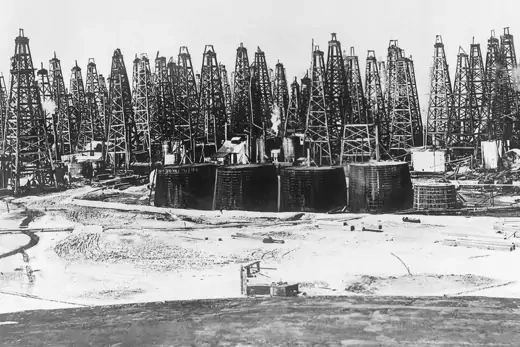
In 1880, the United States is responsible for 85 percent of the world’s crude oil production and refining, and kerosene is the fourth largest U.S. export. However, U.S. dominance of European and Asian oil markets is challenged by new oil finds controlled by Great Britain, the Netherlands, and Russia. Still, over the next two decades, major oil finds in states such as California, Oklahoma, and Texas help increase U.S. production from about twenty-six million barrels of oil annually to around sixty-four million barrels per year. By 1900, more than two hundred oil byproducts—including fuel for stoves and internal combustion engines, as well as lubricants for industrial machinery—begin to enter daily life. The 1901 Spindletop gusher—the largest to date—fuels a major oil rush in Texas, and U.S. oil production nearly triples in a decade.
The Model T

Henry Ford’s invention of the Model T in 1908—the world’s first inexpensive, mass-produced car—helps pave the way for a significant increase in auto ownership. By 1910, U.S. consumption of petrol (gasoline) surpasses kerosene. By 1927, the United States is the most motorized country in the world, with one motor vehicle for roughly every five people. Comparatively, other major industrial countries like Britain, France, and Germany have about one motor vehicle for every forty-four people. The United States continues to lead auto ownership per capita for the next century, and refined-motor fuel becomes the country’s predominant use of oil.
Birth of U.S. Oil Majors

By the 1880s, John D. Rockefeller’s Standard Oil owns 90 percent of the U.S. oil refineries and pipelines and the world’s largest oil tanker fleet. In 1906, the U.S. government takes the company to court for violating the Sherman Antitrust Act of 1890. The U.S. Supreme Court rules in favor of the government in May 1911. In July, Standard Oil is broken into separate entities, including those that later become Chevron, Amoco, Mobil, Conoco, and Exxon. These companies come to dominate much of the international oil market for the next six decades.
World War I
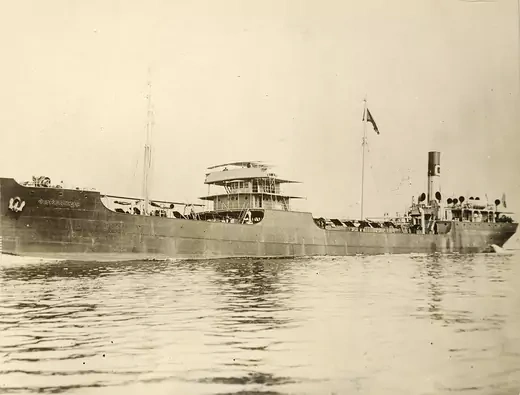
With the onset of World War I, oil becomes vital for modern warfare, fueling ships, land vehicles, and planes. German attacks disrupt U.S. oil exports to Britain and France, causing oil shortages in those countries. When the United States enters the war allied against Germany in 1917, the Wilson administration steps up efforts to supply oil to Britain and France. U.S. production cannot meet both domestic and war demand, so the United States begins importing oil from Mexico to close the gap. During the U.S. war effort, Mexican imports average between 2.5 million barrels and 4 million barrels of oil per month, supplementing U.S. production of about 30 million barrels a month.
Addressing Oil Insecurity
In 1919, the U.S. Geological Survey estimates U.S. oil supplies will run out in ten years, triggering the country’s first oil security fears. Though the United States produces roughly one million barrels of oil per day, or 65 percent of global oil supplies, more than 90 percent is consumed domestically. By 1920, crude prices increase to $3 a barrel, more than double the price in 1914. Congress passes the Mineral Leasing Act of 1920 [PDF], which requires leasing of federal lands for energy prospecting for the first time. In response to British and French attempts to shut U.S. oil companies out of their Middle East protectorates, the law includes a provision denying access to U.S. mineral rights by any foreign entities whose governments deny similar access to U.S. companies. U.S. oil companies also begin pursuing concessions in Latin America.
The Red Line Agreement
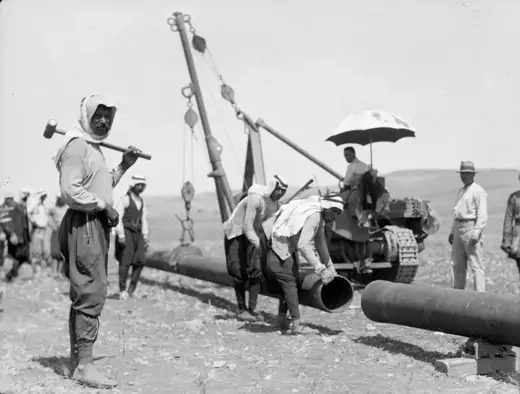
Following British and French attempts to shut U.S. oil companies out of regions they control in the Middle East, the U.S. government begins active oil diplomacy, insisting on an “open door” policy that would allow all companies to compete for foreign concessions regardless of national origins. But the doctrine fails to take hold. Instead, a consortium of seven oil companies is given financial interest in the Iraq Petroleum Company, and the companies agree to not independently develop oil in an area that spans from Turkey to Iraq and Saudi Arabia, but excludes Egypt, Iran, and Kuwait. This 1928 Red Line Agreement with its “self-denial clause” allows seven companies, five of which are American, to control the bulk of Mideast oil production by the early 1930s.
Oil Quotas

Technological breakthroughs and increasing oil production in Latin America, the Middle East, and the United States lead to overproduction. Disproving shortage projections by the U.S. Geological Survey, in less than a decade U.S. oil production more than doubles from what it was in 1920. Britain’s attempt to stabilize European oil prices through the 1928 Achnacarry Agreement, which limits sales by oil producers, is met with mixed success. In 1931, oil prices plummet to just a few cents a barrel. In 1933, the U.S. government imposes a production quota system for states and a duty tax on imported oil to keep cheap oil from flooding the market. Though the Supreme Court overturns the federal quota system in 1935, U.S. oil-producing states voluntarily continue it and prices begin to recover.
Nationalization
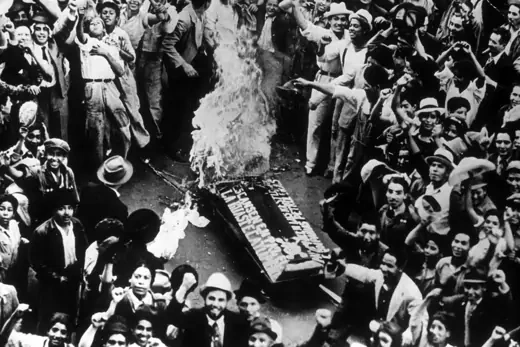
Governments begin to take a more active role in the oil industry. Iranian leader Reza Shah Pahlavi in 1932 cancels the concession of the British oil company Anglo-Persia but then later retreats after striking a deal for a fixed royalty and an increase in Persian laborers employed by the company. Meanwhile, European governments impose import quotas, set prices, and require fuel blending with ethanol made from excess crops, as well as requiring investment in domestic oil infrastructure. In 1938, the Mexican government nationalizes the oil industry and revokes U.S. oil concessions. The U.S. government does not retaliate, in part due to fears Mexico will align with Germany in World War II. Mexico’s actions foreshadow a wave of oil nationalizations that will follow in the decades after the war.
Oil Embargo on Japan
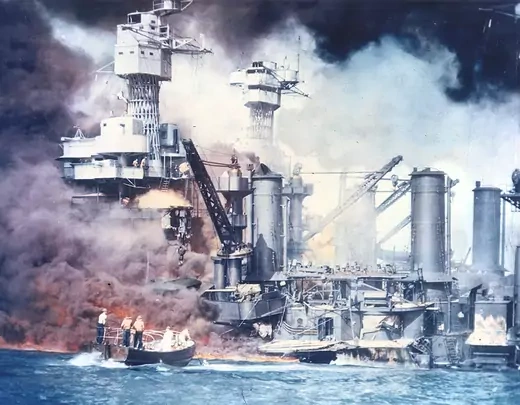
At the start of World War II, the United States is responsible for 60 percent of world production, followed by Russia and Venezuela. Japan, heavily reliant on U.S. oil imports, begins stockpiling oil and equipment shortly before it invades Indochina. In response, the U.S. government imposes controls on oil exports to Japan, effectively cutting off oil supplies in the summer of 1941. On December 7, Japan attacks Pearl Harbor but fails to target the Navy’s on-island oil storage—about four million barrels—leaving it to fuel the surviving Pacific fleet.
Gas Rationing

By 1941, oil shipments from the United States to allies in Europe are impeded by German U-boat attacks. When the United States enters the war, it embarks on a nationwide rationing plan that includes gas coupons and limiting driving speed to thirty-five miles an hour. Efforts also are made to bolster U.S. oil production and transport. Meanwhile, Venezuela enacts a new “fifty-fifty” oil law, which gives the country half of all oil profits but leaves U.S. concessions in place.
Budding U.S.-Saudi Relations
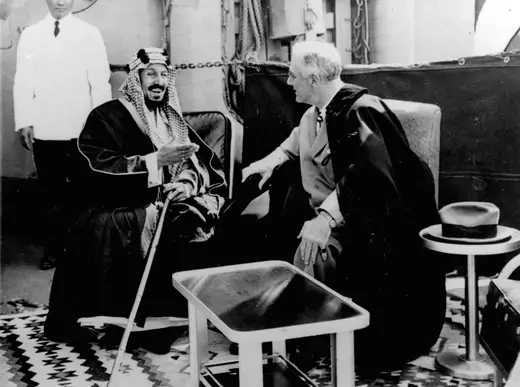
In 1938, Saudi Arabia is found to have vast quantities of oil. In 1943, with concerns growing about the diminishing U.S. oil production capacity, President Franklin Roosevelt declares Saudi oil vital to U.S. security and provides financial support. In February 1945, Roosevelt and Saudi King Abdul Aziz meet aboard a U.S. ship on the Suez Canal to discuss closer ties. A few years later, the world’s biggest oil field is found in Saudi Arabia, and the country quickly becomes the world’s largest exporter of oil—though it does not become a significant U.S. supplier for several decades.
End of the War

At the end of World War II, the United States is an economic and military superpower. The country plays a central role in the global recovery, including providing energy aid to a devastated Europe. The war’s end also brings about the end of U.S. gas rationing. The U.S. auto industry booms, with the number of cars in the United States jumping from twenty-six million to forty million in the five years after the war. In the decades that follow, the transportation sector’s (mainly automobiles) share of oil consumption rises from about 50 percent to more than 70 percent.
The Marshall Plan

The European Recovery Program, also known as the Marshall Plan, helps war-torn Europe get access to petroleum imports. Over the course of the forty-five-month program, the United States supplies more than $11 billion in oil aid, about 10 percent of the total aid provided by the program. The continent begins to become more dependent on oil for its energy needs as Europeans turn away from coal. But European oil needs begin to be increasingly met by the Middle East and not the United States. The United States is a net oil exporter in 1945, but by 1950 it is importing nearly one million barrels a day and within two decades the country is importing over six million barrels per day—more than a third of U.S. demand.
U.S.-Iran Oil Consortium
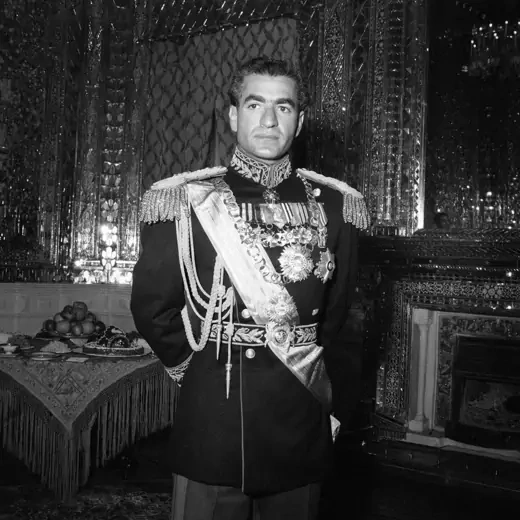
In August 1953, the Iranian military, with the help of British and U.S. intelligence agencies, overthrows Iranian Prime Minister Mohammad Mossadeq—who nationalized the country’s oil industry two years earlier. The U.S. government works with U.S. oil majors and the Iranian government—now run by the Shah—to bring Iranian oil back online following a British embargo of oil shipments. Iran’s oil remains nationalized, but in October 1954 the government agrees to a consortium of mainly U.S. companies to manage Iran’s oil industry. To prevent running afoul of U.S. antitrust laws, U.S. oil majors relinquish a small portion of their share in the consortium to allow independent U.S. producers to buy in.
Suez Canal Crisis
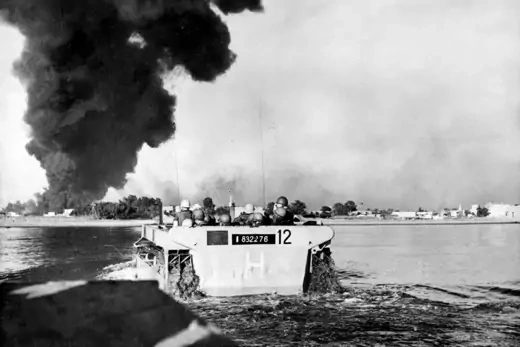
In July 1956, Egypt nationalizes the Suez Canal, which has been controlled by Britain and France. The two countries, in a coordinated attack with Israel, temporarily seize the canal in October. Half the canal’s traffic is petroleum, and the ensuing crisis from its closure threatens Middle East oil shipments, which supply about eight hundred thousand barrels a day to Europe. The intervention stokes Cold War tensions, and U.S. President Dwight D. Eisenhower compels a withdrawal to avoid a showdown with the Soviet Union. In a 1957 speech to Congress, Eisenhower says the Middle East would be a prize for international communism and asks Congress to provide economic and military support for any nation or groups of nations in the region with “governments manifestly dedicated to the preservation of independence and resistance to subversion.”
Cap on U.S. Oil Imports
In 1959, the world once again faces an oversupply of oil and prices are slashed. U.S. President Dwight Eisenhower imposes the Mandatory Oil Import Program, a quota system on oil imports, so that they cannot exceed more than 9 percent of domestic consumption. The program also gives preferential treatment to Canada and Mexico. The quota lasts for fourteen years. U.S. oil prices remain stable, and eight years later are 60 percent to 70 percent above Mideast crude prices.
Creation of OPEC

Arab nations, relying heavily on oil revenue, are increasingly frustrated by oil price cuts by largely Western oil companies—and by U.S. import caps, which also depress prices. In August 1960, Western oil majors once again slash prices without consulting exporting countries. In September, representatives from Iran, Kuwait, Qatar, Saudi Arabia, and Venezuela meet in Baghdad with Iraqi officials—together they represent 80 percent of the world’s crude exports. On September 14, the Organization of the Petroleum Exporting Nations (OPEC) is formed with the purpose of defending oil prices. However, in its initial years, OPEC exerts little influence and is virtually ignored by the U.S. government.
First Arab Oil Embargo
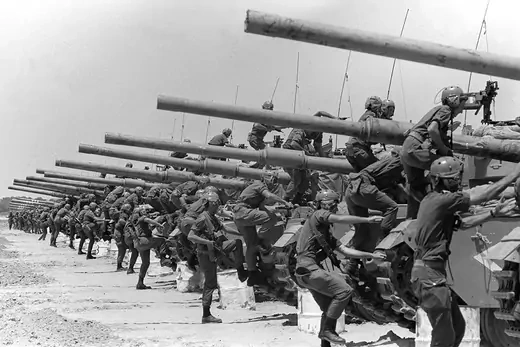
On June 6, 1967, Israel enters into an armed conflict with Egypt, Jordan, and Syria, known as the Six Day War. The next day, Arab oil ministers call for an embargo on countries friendly to Israel. Oil shipments halt to the United States and Britain. U.S. domestic production, however, surges by one million barrels a day and largely offsets the temporary loss of Mideast oil globally. By September, the embargo is lifted, and, for a short time, the world experiences another oil glut.
Tehran and Tripoli Agreements
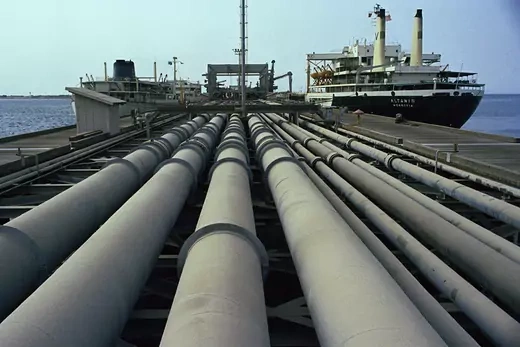
In April 1971, OPEC moves to rebalance profit sharing and oil prices and refuses to allow foreign oil companies to deal with the organization as a whole. The bloc instead forces them into separate negotiations, one for Persian Gulf producers (Tehran Agreement) and one for producers on the Mediterranean (Tripoli Agreement), resulting in higher prices. The incident marks a turning point for OPEC’s clout. Within a decade, many of OPEC’s members begin to partially or fully nationalize their oil resources and have greater influence in setting oil prices. By the end of the 1970s, international oil companies have unfettered access to just 7 percent of the world’s oil reserves, down from 85 percent in the 1960s. U.S. oil production, meanwhile, peaks in 1970 and declines about 45 percent within three decades.
End of U.S. Import Quota

U.S. spare production capacity is evaporating. Faced with a looming gasoline shortage, in April 1973 President Richard Nixon announces he is ending the Mandatory Import Program—which sets limits on oil imports—but rejects recommendations to implement conservation efforts and develop fuel alternatives. The import mandate comes two years after Nixon imposes oil price controls as part of his anti-inflation strategy. Oil imports, representing about 30 percent of U.S. consumption in 1973, increase to nearly 50 percent of consumption [PDF] within four years.
Oil Crisis

Syria and Egypt attack Israel on October 6, 1973, on the Jewish holy day of Yom Kippur. On October 19, with the war still underway, the Nixon administration announces a $2.2 billion military aid package to Israel. Arab states respond by suspending oil shipments to nations supportive of Israel. The embargo reduces traded oil supplies by 14 percent internationally. Gasoline prices in the United States increase as much as 40 percent within a few months. Consumers in Europe, Japan, and the United States begin to panic over oil shortages. Hours-long lines at gas stations form across the United States as people start to hoard gas supplies following gas rationing and price controls. President Nixon on November 7 announces a swath of new energy policies and “Project Independence,” a goal of U.S. energy independence by 1980.
End of the Second Arab Oil Embargo
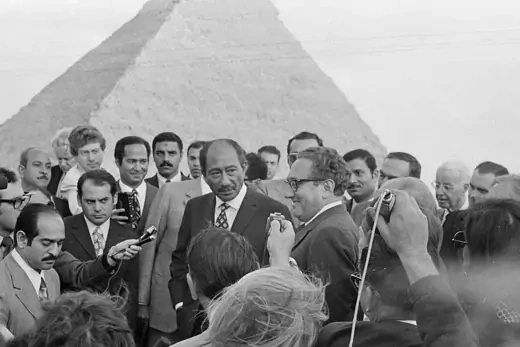
With the 1973 oil embargo after the Yom Kippur War wreaking economic havoc, U.S. Secretary of State Henry Kissinger starts “shuttle diplomacy,” helping attain disengagement between Israel and Egypt in January 1974. Arab oil ministers agree to end the embargo on March 18, 1974, on the condition that the United States also promotes Israeli-Syrian disengagement. Kissinger helps achieve an agreement between the two states in May, which includes a cease-fire and withdrawal of Israeli forces from some captured territories. The world’s top economies form the International Energy Agency to coordinate “in times of oil supply emergencies.” They also come together at a summit in France in 1975 to discuss the global economy and energy dependency. This heads-of-state forum is called the Group of Six and later becomes the G8 and then the G7.
U.S. Energy Conservation Spurred

The 1973 oil crisis spurs the U.S. Congress to mandate a fifty-five miles per hour speed limit on highways and to pass the Energy Policy and Conservation Act of 1975, which establishes the Strategic Petroleum Reserve and fuel efficiency standards for new automobiles. Nixon-era price controls remain on domestic oil, depressing production. Between 1974 and 1978, U.S. consumption of imports nearly doubles, and U.S. oil demand rises by about 2.1 million barrels per day. In 1977, the Carter administration organizes energy agencies into the Department of Energy. President Carter also puts out his first set of energy proposals focusing mainly on conservation, and signs legislation in 1978 to encourage fuel switching and efficiency by electric utilities and other U.S. industries.
Iranian Revolution
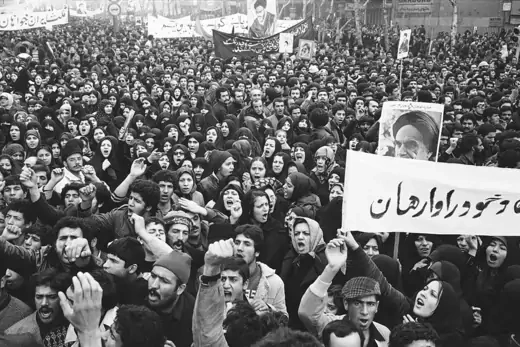
In October 1978, thousands of oil workers go on strike in Iran, as part of a cycle of unrest protesting leader Mohammed Reza Shah. Oil output in Iran drops from more than five million barrels a day to zero by December—amounting to about a 5 percent loss in global production. The Shah is forced to leave the country in January 1979. Exiled senior Shiite cleric Ayatollah Ruhollah Khomeini returns to assume control of Iran under an Islamic government. A group of Iranian students takes over the U.S. embassy in Tehran on November 4, 1979, taking sixty-three American hostages for more than four hundred days. President Carter responds by severing diplomatic relations and embargoing Iranian oil imports. Between January 1979 and December 1979, global oil prices more than double.
Crisis of Confidence
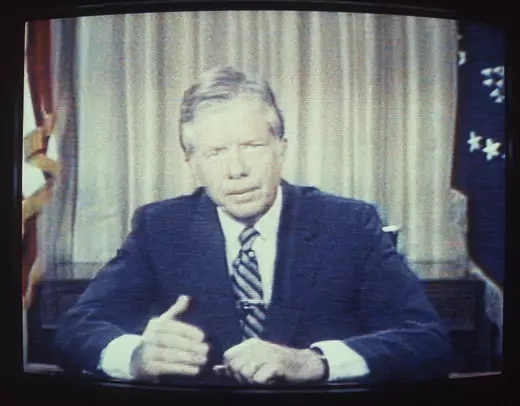
Iran’s revolution sparks panic over another oil-supply shortage, and oil prices double. Long gas lines return to the United States. In July, President Jimmy Carter gives his fifth major speech on energy policy, which includes announcing more energy conservation measures and a phase-out of oil price controls. A frustrated Carter admonishes the nation for worshiping “self-indulgence and consumption” and having “a crisis of confidence.” In 1980, Carter signs the Energy Security Act [PDF], which includes incentives for geothermal, solar, and biomass energy to give electricity generators new alternatives to oil. It also establishes the U.S. Synthetic Fuels Corporation, intended to produce two million barrels a day in liquid fuel from non-petroleum sources like coal within five years.
Iran-Iraq War

Iran and Iraq go to war in September 1980. Though the United States is officially neutral, it renews diplomatic ties with Iraq, which have been severed since the 1967 Arab-Israeli conflict. Continuing attacks on both Iraqi and Iranian oil facilities remove four million barrels a day in oil production from the global market. The Reagan administration issues a national security directive in 1983 [PDF] to increase the U.S. military presence in the Persian Gulf to help protect the oil facilities and shipments to allies. The war lasts eight years.
Focus on Offshore Drilling
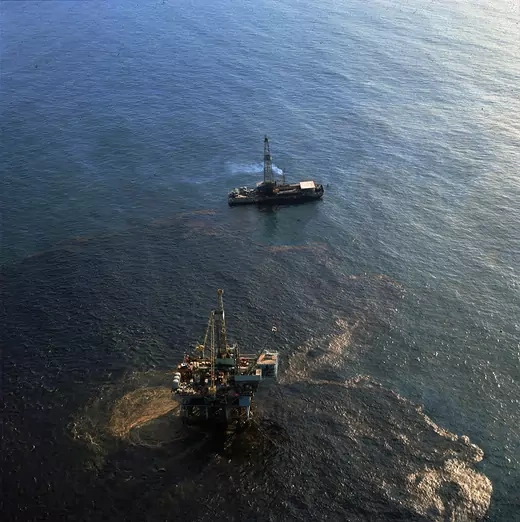
The U.S. Congress imposes a moratorium on new offshore drilling off the California coast in 1981 in response to public outcry and lingering environmental concerns caused by an oil spill off the coast of Santa Barbara in 1969. Within a few years, the ban is extended to all new leases in U.S. coastal waters, except for parts of the Gulf of Mexico and some waters off the coast of Alaska. This ban continues to the present day. However, existing offshore drilling, from leases before the moratorium and from allowed parts of the Gulf and Alaska, represents about 8 percent of all U.S. production in 1981. Between increasing production in allowed offshore areas and a drop in overall U.S. production, offshore drilling rises to about 30 percent of U.S. production in the next three decades.
U.S. Diversifies Energy Consumption
The Reagan administration fully deregulates crude prices in 1981, allowing U.S. producers to raise prices to market levels. Non-OPEC production begins to outstrip that of OPEC—which hinders the cartel’s influence on oil prices. Global demand begins to drop due to high prices and conservation measures, and another oil surplus ensues. By 1982, the United States imports about 28 percent of its oil, down from more than 45 percent in 1977. By 1985, U.S. fuel economy averages for automobiles reach nearly 28 mpg, up from 20 mpg in 1978, and consumer fuel switching for heating and electricity helps lower oil consumption. Oil prices drop from a yearly average of $35 per barrel in 1981 to less than $15 in 1986. The collapse in price encourages oil companies to shift to cheaper foreign exploration, and U.S. imports begin to steadily rise again.
Exxon Valdez Oil Spill

The super tanker Exxon Valdez strikes a reef in Prince William Sound, Alaska, spilling eleven million barrels of oil and damaging coastline and fisheries. Considered one of the worst environmental disasters in U.S. history, the spill—and its $2 billion cleanup cost—bolsters the environmental movement and leads to policies that further restrict offshore drilling. In 1990, Congress passes the Oil Pollution Act [PDF] for offshore accidents, which creates a three-tiered emergency response plan for spills, caps liability for operators of offshore facilities, and establishes a trust fund that makes up to $1 billion available for each spill incident.
Iraq's Invasion of Kuwait

Iraq invades Kuwait on August 2, 1990, following a dispute over the Rumaila oil field on the border. In a speech on August 8, 1990, President George H.W. Bush says Iraq’s aggression poses an economic threat to the United States, which now imports half its oil. Bush also declares the “sovereign independence of Saudi Arabia [a] vital interest” and deploys troops to the country. Nations dependent on Persian Gulf imports, such as Japan, provide much of the funding for a U.S.-led, multinational military effort to liberate Kuwait in January 1991. The Bush administration releases thirty-four million barrels of oil from the U.S. Strategic Petroleum Reserve in anticipation of an oil shock, but contrary to predictions, oil prices drop from about $30 per barrel in September to less than $20 in January. Iraq surrenders in late February 1991.
A Nation of SUVs

In 1993, the Clinton administration announces a partnership to develop and produce affordable, fuel-efficient, low-emission vehicles. But inexpensive oil and a booming economy drive up consumption in the United States. While European and Japanese car companies move ahead with commercialization of the first hybrid passenger vehicle, sales of gas-guzzling sports utility vehicles (SUVs)—considered light trucks and thus exempted from tougher U.S. fuel economy standards—explode. SUVs make up a large part of the fleet of U.S. automakers, garnering significant profits in comparison to smaller, more fuel-efficient cars. Between 1993 and the country’s record demand for oil in 2005, consumption increases by 3.6 million barrels a day to 20.8 million barrels per day.
Kyoto Protocol
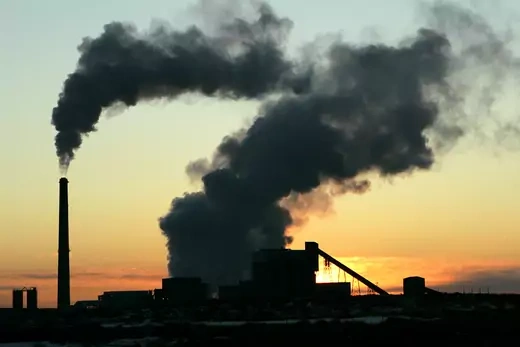
In 1997, most of the world’s leaders sign the Kyoto Protocol, an international mechanism for countries to reduce and adapt to rising greenhouse gas levels in order to mitigate climate change. But the United States, the largest greenhouse emitter of the time, refuses to ratify the treaty and for the next decade faces international criticism for its slow adoption of emissions-reduction policies. And though a third of manmade emissions come from petroleum, U.S. policy on oil consumption remains focused on energy security and air quality. Environmental advocates target the U.S. oil and auto industries for lobbying against climate policy in the country for the next decade.
Birth of the Super Majors
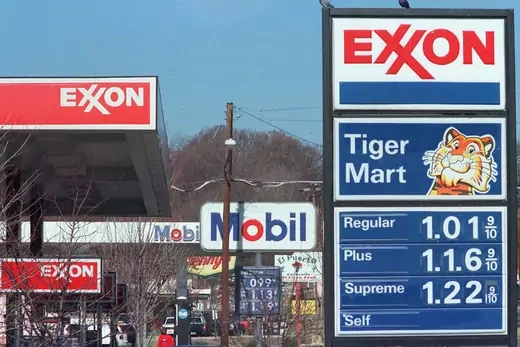
Asia’s economic crisis in 1997 causes a drop in demand in what has been a growth region for oil markets. Though OPEC tightens its oil production quota, global prices plunge to below $10 per barrel at the end of 1998, down from nearly $20 per barrel in late 1997. The downturn, plus an increasingly constrained environment for oil concessions globally, encourages a string of oil mergers among the world’s largest private oil companies, including ones between BP and Amoco (the largest foreign takeover of a U.S. company to date), Exxon and Mobil, and Texaco and Chevron. Accused of stifling competition, these mergers face political scrutiny [PDF] in the next decade as U.S. gas prices increase significantly.
New Assertive Oil Powers

In February 1999, Hugo Chavez assumes office as president of Venezuela, and embarks on a social revolution that includes financing new social programs with the country’s oil revenues. Venezuela continues to be one of the largest sources of U.S. oil imports, but Chavez is increasingly critical of U.S. foreign policy over the course of the next decade and threatens repeatedly to cut off oil shipments. In 1999, Vladimir Putin takes office as president of Russia, which has the largest conventional oil reserves outside of OPEC. Both Venezuela and Russia nationalize much of their oil resources and restrict access by international oil companies.
Canada Overtakes Saudi Arabia
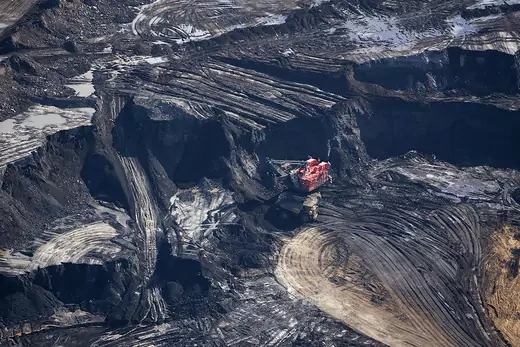
In 2004, Canada surpasses Saudi Arabia as the largest single exporter of oil to the United States, providing 1.6 million barrels per day compared to the Saudi’s 1.5 million barrels. A decade before, Canada begins investing heavily to develop its oil sands, which requires more money and effort to extract and refine than conventional oil. Many estimate oil sands place the country’s oil reserves second to Saudi Arabia. In 1999, oil sands represent about 15 percent of total Canadian crude production, but by 2010 oil sand production is nearly half. Still, heavily polluting oil sand production increasingly becomes an environmental concern.
Renewable Fuel Support
In 2005, the U.S. Congress passes the Energy Policy Act, which includes new incentives for transportation fuel alternatives and flex-fuel cars as well as new subsidies for domestic oil exploration. The law mandates that 7.5 billion gallons of renewable fuels be blended into gasoline by 2012. In his 2006 State of the Union address, U.S. President George W. Bush says “America is addicted to oil.” The law is criticized for adding billions in federal subsidies to the oil industry, and subsidies of corn-based biofuel are criticized as a threat to food security and the environment. Some energy experts criticize U.S. tariffs on Brazilian sugarcane ethanol, which is cheaper and more energy efficient to produce.
Skyrocketing Oil Prices

In 2006, a time of near record-high U.S. oil consumption and imports, oil prices begin to rise steadily, topping a record $147 a barrel in the summer of 2008. This translates to gasoline averages above $4 per gallon in much of country. Experts debate the cause of the record prices, blaming it on factors such as the economic rise of China and India, commodity market speculation, and basic issues of supply. Fuel prices and high food prices begin to cause unrest around the world. In the United States, high gas prices in a presidential election year invigorate debate about increasing domestic production, especially ending the moratorium on offshore drilling and in Alaska’s Arctic National Wildlife Reserve. “Drill baby drill” becomes a rallying cry for the Republican Party. Shortly after the global financial crisis begins in 2008, oil prices plummet.
Energy Independence and Security Act

In 2007, Congress passes the Energy Independence and Security Act, which will increase Corporate Average Fuel Economy (CAFE) standards from 27.5 mpg to 35 mpg by 2020, and ends the light truck exclusion. The law also mandates greater production of non-corn-based ethanol, and requires biofuels blended with gasoline and diesel to be at least 20 percent less in greenhouse gas lifecycle emissions than the petroleum-based fuels. In May 2009, the Obama administration announces accelerated CAFE standards of 39 mpg for cars and 30 mpg for light trucks, which the administration highlighted as part of its climate change policy goals.
BP Oil Spill

In the spring of 2010, U.S. President Barack Obama lays out his plans for U.S. energy policy, including supporting more biofuels and opening more U.S. waters to offshore oil drilling. But in April, a deepwater drilling rig explodes and sinks in the Gulf of Mexico, causing a massive, four-month oil spill. The Obama administration, in response, places a temporary ban on all new offshore drilling projects in order to review U.S. safety and environmental enforcement. Calls renew for strengthened measures to reduce U.S. oil consumption, now at less than nineteen million barrels per day, down nearly two million barrels from 2005 record levels.
Libya Rocks Oil Markets

In February 2011, Libya becomes the first major oil-producing nation to join a spate of popular uprisings in the region, which topples regimes in Egypt and Tunisia. With the largest reserves in Africa, Libya represents about 2 percent of global oil production. Global oil prices spike nearly 10 percent in one day. Though the country does not supply oil to the United States, concerns grow that the situation in Libya and potential unrest in other oil-producing nations could lead to a new global oil crisis. In a March 30 speech, U.S. President Barack Obama says: “We will keep on being a victim to shifts in the oil market until we get serious about a long-term policy for secure, affordable energy.” He pledges to reduce U.S. oil dependence by one-third within a decade.
U.S. Releases Oil from Strategic Reserve
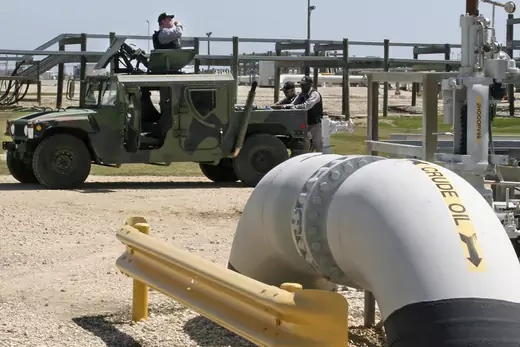
The Obama administration announces it will release thirty million barrels from the U.S. Strategic Petroleum Reserve over thirty days. The administration says the move is to offset the loss of Libya’s 1.5 million bpd in output since civil war erupted in February. The U.S. release coincides with the release of another thirty million barrels from the reserves of other members of the International Energy Agency. The IEA says “greater tightness in the oil market threatens to undermine the fragile global economic recovery.” The coordinated release comes after OPEC ministers fail to agree to greater output. The U.S. reserve sale represents the fourth major drawdown since the reserve’s initiation in 1977. The administration’s decision draws criticism from some analysts and political opponents for its timing, rationale, political overtones, and uncertain impact on oil markets.
U.S. Oil Imports Hit Two-Decade Low
Imports of crude oil and petroleum products fall to less than 260,000 barrels per day, the lowest in almost two decades, according to the U.S. Energy Information Administration. The reduced reliance on foreign oil is the result of both declining demand and a domestic energy revolution which, through the combination of hydraulic fracturing and horizontal drilling, unlocked vast reserves of “tight oil” in shale rock formations. Tight oil production surges from less than one million barrels a day in 2010 to over four million barrels a day by December 2015, exceeding the individual production of every OPEC member except Saudi Arabia.
OPEC Meets as Global Oil Prices Tumble

U.S. tight oil producers contribute to a global supply glut that puts downward pressure on prices. By November, crude oil falls below $75 a barrel, down from $110 in June. OPEC members meet in Vienna, where, despite opposition from some members who want to cut OPEC oil production to halt the price slide, Saudi Arabia pushes the group to maintain a production target of thirty million barrels per day. The organization meets and regularly exceeds that target, leading to further price declines below $50 a barrel by early 2015, which squeezes the finances of oil-exporting countries and forces unconventional drillers in the United States to curb costs and sharply cut production.
Obama Administration Rejects Keystone XL Pipeline
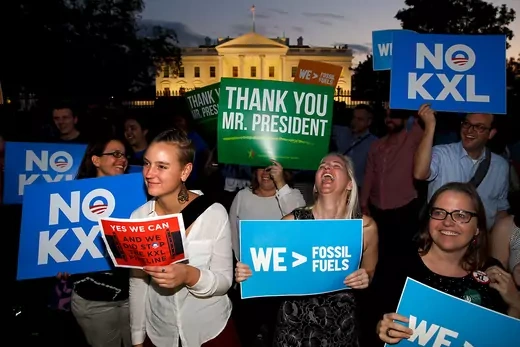
President Barack Obama rejects the proposed Keystone XL pipeline, which would have transported more than eight hundred thousand barrels of oil per day from Canada to Texas. Subject to multiple rounds of State Department review since its conception in 2008, supporters said it would have created jobs and enhanced energy security, while opponents worried about potential damage to the environment from spills and increased carbon emissions. Debate over the merits of the cross-border pipeline will continue, as TransCanada, the company behind the project, files a lawsuit against the U.S. government charging discriminatory treatment under the North American Free Trade Agreement (NAFTA).
Congress Lifts Oil-Export Ban
Congress votes to lift four-decade-old restrictions on U.S. crude oil exports, and a shipment immediately leaves the port of Corpus Christi, Texas, for sale in Europe. The shipment consists of light sweet crude oil drawn from south Texas’s Eagle Ford shale deposits. Even as the United States continues to import oil, opportunities for exports will arise since many of the country’s existing refineries are not optimized to process the type of light crude drawn from shale. However, most analysts believe that the impact on production, prices, and geopolitics of lifting the restrictions will be modest.
Paris Agreement

The Paris Agreement—signed by more than 190 countries, including the United States—enters into force. The most ambitious climate accord to date, the agreement requires all parties to set targets to reduce greenhouse gas emissions, with the goal of arresting the rise in the average global temperature. Countries also agree to aim for net-zero carbon emissions by mid-century. The United States pledges to cut its emissions by more than 25 percent from 2005 levels by 2025, a move that requires transitioning away from fossil fuels, including oil. Although the accord does not include enforcement mechanisms, there are periodic performance reviews meant to encourage countries to adopt more ambitious targets.
Trump’s ‘America First’ Energy Plan

After campaigning on a promise to boost U.S. oil production and achieve energy independence, President Donald Trump begins rolling back his predecessor’s policies. In June, Trump announces the U.S. withdrawal from the Paris Agreement, which takes effect in November 2020. His administration later scraps Obama’s tougher fuel efficiency standards for cars and trucks, which the Environmental Protection Agency says will result in about two billion more barrels of oil consumed. The U.S. fracking boom continues, with the administration leasing four million acres of federal land to fossil fuel companies. Trump also revives the Keystone XL pipeline and, with support from the Republican-controlled Congress, opens the Arctic National Wildlife Refuge (ANWR) in Alaska for oil drilling despite opposition from Democrats, environmental activists, and some Alaska Native groups. Alaskan lawmakers and other Alaska Native groups support the move due to the expected revenue and job growth.
COVID-19 Pandemic

The world is rocked by the emergence of a new coronavirus disease, COVID-19, that quickly becomes a global pandemic. Response measures, including stay-at-home orders, trigger a sharp drop in the demand for oil. Falling oil prices create a rift within OPEC and lead to a price war between Saudi Arabia and Russia, with Riyadh ramping up production to further slash prices in an effort to force Moscow to the table. Oil prices hit rock bottom; in April, a major benchmark price for U.S. crude oil briefly falls below zero for the first time in history. After Whiting Petroleum Corporation, a major U.S. producer, declares bankruptcy, President Trump attempts to broker an OPEC deal to prevent further damage to the U.S. industry. After Trump intervenes, OPEC and Russia agree to curb production and raise prices.
Biden’s New Direction
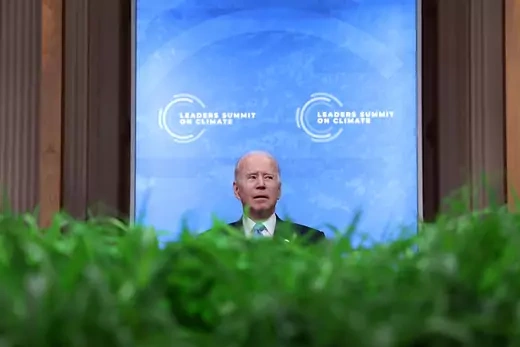
President Joe Biden is sworn into office and promises to take aggressive action on climate change. He rejoins the Paris Agreement and pledges to cut U.S. emissions by at least 50 percent of 2005 levels by 2030—and achieve net-zero emissions by 2050. To reach that goal, Biden calls for a return to higher fuel efficiency standards for cars and trucks, as well as measures to spur the use of electric vehicles, among other proposals. Biden cancels the Keystone XL pipeline and suspends drilling leases in the ANWR. However, approval for drilling on other federal lands continues at a record pace. As the pandemic abates in the United States, demand for oil rebounds and gas prices surge to a seven-year high.
Russia’s War With Ukraine
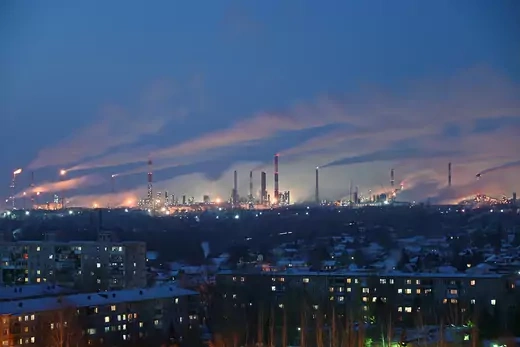
Russia’s invasion of Ukraine causes turmoil in global oil markets. Biden blocks U.S. imports of oil from Russia, and Western sanctions cause energy companies to withdraw from the country. Oil prices, already rising in the wake of the pandemic, surge to their highest level since 2008. In response to near-record gasoline prices, U.S. lawmakers on both sides of the aisle call for boosting domestic oil production, though some in Congress urge a quicker transition to renewable energy. The United States and other members of the International Energy Agency announce plans to collectively release sixty million barrels of oil from strategic reserves. Meanwhile, the Biden administration considers smoothing rocky relations with Iran, Saudi Arabia, and Venezuela in the hope that those countries will supply more oil. Senior U.S. officials travel to Caracas for the first time since 2019, and the Biden administration pushes to finalize negotiations on reviving the 2015 Iran nuclear agreement and lifting U.S. sanctions on Tehran.
U.S. Oil Production Reaches Record High As Climate Concerns Mount
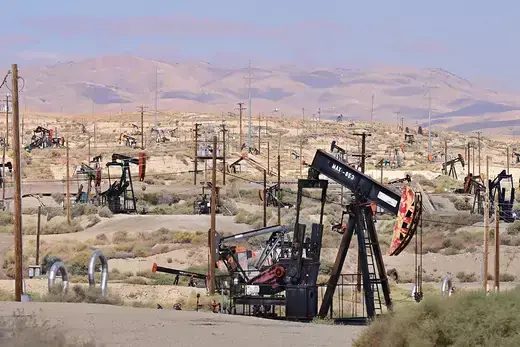
U.S. crude oil production surpasses thirteen million barrels a day for the first time, making the United States the world’s largest producer of the commodity. The surge in production keeps U.S. gasoline prices low despite several rounds of voluntary production cuts by the OPEC+ coalition, which includes Russia. However, the United States still imports more than it exports amid high domestic energy demand and a mismatch between refining capacity and the type of crude oil produced by U.S. shale fields. Meanwhile, some governments push for a global deal to phase out fossil fuels at the year-end COP28 summit, citing their contribution to climate change and the year’s record heat.